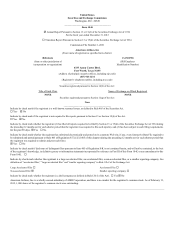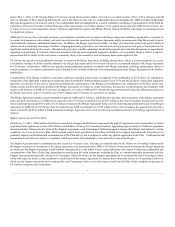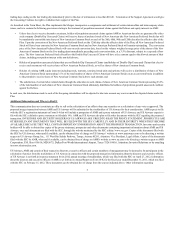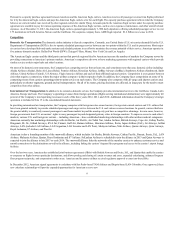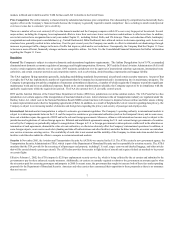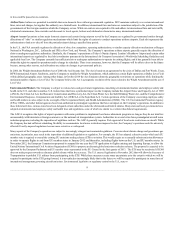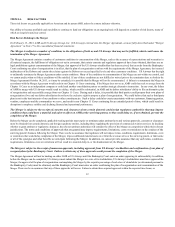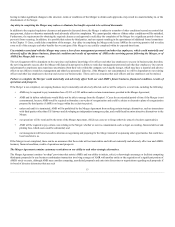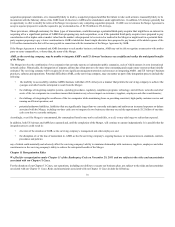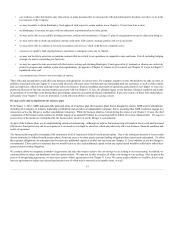American Airlines 2012 Annual Report Download - page 6
Download and view the complete annual report
Please find page 6 of the 2012 American Airlines annual report below. You can navigate through the pages in the report by either clicking on the pages listed below, or by using the keyword search tool below to find specific information within the annual report.
Pursuant to a capacity purchase agreement between American and the American Eagle carriers, American receives all passenger revenue from flights performed
for it by the American Eagle carriers and pays the American Eagle carriers a fee for each flight. The capacity purchase agreement reflects what the Company
believes are current market rates received by other regional carriers for similar flying. Amounts paid to the American Eagle carriers under the capacity purchase
agreement are available to pay for various operating expenses of the American Eagle carriers, such as crew expenses, maintenance, and other aircraft related
expenses. As of December 31, 2012, the American Eagle carriers operated approximately 1,500 daily departures, offering scheduled passenger service to over
175 destinations in North America, Mexico and the Caribbean. On a separate company basis, AMR Eagle reported $1.2 billion in revenue in 2012.
Competition
Domestic Air Transportation The domestic airline industry is fiercely competitive. Currently, any United States (U.S.) air carrier deemed fit by the U.S.
Department of Transportation (DOT) is free to operate scheduled passenger service between any two points within the U.S. and its possessions. Most major
air carriers have developed hub-and-spoke systems and schedule patterns in an effort to maximize the revenue potential of their service. American operates in
five primary domestic markets: Dallas/Fort Worth (DFW), Chicago O’Hare, Miami, New York City and Los Angeles.
The American Eagle carriers and the third party carriers that provide regional feed to American increase the number of markets the Company serves by
providing connections at American’s primary markets. American’s competitors also own or have marketing agreements with regional carriers which provide
similar services at their major hubs and other locations.
On most of its domestic non-stop routes, the Company faces competing service from at least one, and sometimes more than one, domestic airline including:
Alaska Airlines (Alaska), Delta Air Lines (Delta), Frontier Airlines, Hawaiian Airlines, JetBlue Airways (JetBlue), Southwest Airlines (Southwest), Spirit
Airlines, United Airlines (United) , US Airways, Virgin America Airlines and each of their affiliated regional carriers. Competition is even greater between
cities that require a connection, where the major airlines compete via their respective hubs. In addition, the Company faces competition on some of its
connecting routes from carriers operating point-to-point service on such routes. The Company also competes with all-cargo and charter carriers and,
particularly on shorter segments, ground and rail transportation. On all of its routes, pricing decisions are affected, in large part, by the need to meet
competition from other airlines.
International Air Transportation In addition to its extensive domestic service, the Company provides international service to the Caribbean, Canada, Latin
America, Europe and Asia. The Company’s operating revenues from foreign operations (flights serving international destinations) were approximately 40
percent of the Company’s total operating revenues in each of the three years 2012, 2011, and 2010. Additional information about the Company’s foreign
operations is included in Note 15 to the consolidated financial statements.
In providing international air transportation, the Company competes with foreign investor-owned carriers, foreign state-owned carriers and U.S. airlines that
have been granted authority to provide scheduled passenger and cargo service between the U.S. and various overseas locations. In general, carriers that have
the greatest ability to seamlessly connect passengers to and from markets beyond the nonstop city pair have a competitive advantage. In some cases, however,
foreign governments limit U.S. air carriers’ rights to carry passengers beyond designated gateway cities in foreign countries. To improve access to each other’s
markets, various U.S. and foreign air carriers – including American – have established marketing relationships with other airlines and rail companies.
American currently has marketing relationships with Air Berlin, Air Pacific, Air Tahiti Nui, Alaska Airlines, British Airways, Cape Air, Cathay Pacific,
Dragonair, EL AL, Etihad Airways, EVA Air, Finnair, Gulf Air, Hainan Airlines, Hawaiian Airlines, Iberia, Japan Airlines (JAL), Jet Airways, JetStar
Airways, LAN (includes LAN Airlines, LAN Argentina, LAN Ecuador and LAN Peru), Malaysia Airlines, Niki Airlines, Qantas Airways, Qatar Airways,
Royal Jordanian, S7 Airlines, and WestJet.
American is also a founding member of the oneworld alliance, which includes Air Berlin, British Airways, Cathay Pacific, Finnair, Iberia, JAL, LAN
Airlines, Malaysia Airlines, Qantas, Royal Jordanian and S7 Airlines. SriLankan Airlines is scheduled to join the alliance in 2013 and Qatar Airways is
expected to join the alliance in late 2013 or early 2014. The oneworld alliance links the networks of the member carriers to enhance customer service and
smooth connections to the destinations served by the alliance, including linking the carriers’ frequent flyer programs and access to the carriers’ airport lounge
facilities.
Over the last two years, American has established joint business agreements (JBAs) with British Airways and Iberia, JAL, and Qantas that enable the carriers
to cooperate on flights between particular destinations, and allows pooling and sharing of certain revenues and costs, expanded codesharing, enhanced frequent
flyer program reciprocity, and cooperation in other areas. American and its partner airlines received regulatory approval to enter into these JBAs.
In December 2012, American signed agreements to codeshare with Sao Paulo-based TAM Airlines and Bogota-based LAN Colombia. Once approved, these
new codeshare relationships will provide expanded opportunities for American to serve new
6

